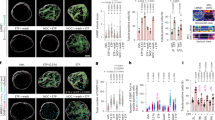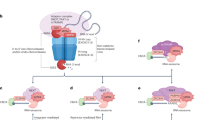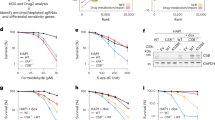Abstract
The receptor for epidermal growth factor (EGF) has been identified as a transmembrane glycoprotein that has tyrosine-specific kinase activity1. The kinase activity of the receptor is enhanced in the presence of EGF (or related peptides), and the phosphorylation of a number of substrates, as well as autophosphorylation of the receptor, has been reported1. Analogous findings have been described for the insulin receptor and the receptor for platelet-derived growth factor (PDGF)2. Thus, a number of hormone receptors and several viral transforming proteins3 appear to share the highly unusual property of tyrosine-specific kinase activity. Nevertheless, the specific relationship between tyrosine kinase activity and the control of cell growth and replication is unknown. It is known that after the initial binding of EGF to the plasma membrane, the hormone together with its receptor is rapidly internalized in endocytic vesicles and the hormone is eventually degraded in lysosomes4. It is possible that the function of EGF is simply to stimulate internalization of its receptor, and that as a result of its altered location the receptor is able to phosphorylate a cytoplasmic component or even interact directly with a nuclear component. We now report that the purified receptor for EGF is able to interact with and nick supercoiled double-stranded DNA in an ATP-stimulated manner.
This is a preview of subscription content, access via your institution
Access options
Subscribe to this journal
Receive 51 print issues and online access
$199.00 per year
only $3.90 per issue
Buy this article
- Purchase on Springer Link
- Instant access to full article PDF
Prices may be subject to local taxes which are calculated during checkout
Similar content being viewed by others
References
Cohen, S. in Biological Response Mediators and Modulators (ed. August, J. T.) 7–12 (Academic, New York, 1983).
Houslay, M. D. & Heyworth, C. M. Trends biochem. Sci. 8, 449–452 (1983).
Bishop, J. M. & Varmus, H. in RNA Tumor Viruses (eds Weiss, R., Teich, N., Varmus, H. & Coffin, J.) 999–1108 (Cold Spring Harbor Laboratory, New York, 1983).
Haigler, H. T. & Cohen, S. Trends biochem. Sci. 4, 132–134 (1979).
Cohen, S., Ushiro, H., Stoscheck, C. & Chinkers, M. J. biol. Chem. 257, 1523–1531 (1982).
Cohen, S., Fava, R. A. & Sawyer, S. T. Proc. natn. Acad. Sci. U.S.A. 79, 6237–6241 (1982).
Carpenter, G., King, L. & Cohen, S. J. biol. Chem. 254, 4884–4891 (1979).
Maniatis, T., Fritsch, E. F. & Sambrook, J. in Molecular Cloning, 93–94 (Cold Spring Harbor Laboratory, New York, 1982).
Author information
Authors and Affiliations
Rights and permissions
About this article
Cite this article
Mroczkowski, B., Mosig, G. & Cohen, S. ATP-stimulated interaction between epidermal growth factor receptor and supercoiled DNA. Nature 309, 270–273 (1984). https://doi.org/10.1038/309270a0
Received:
Accepted:
Issue Date:
DOI: https://doi.org/10.1038/309270a0
This article is cited by
-
The developing role of receptors and adaptors
Nature Reviews Cancer (2006)
-
Translocation of ErbB receptors into the nucleus
Revista de Oncología (2003)
-
Signalling shortcuts: cell-surface receptors in the nucleus?
Nature Reviews Molecular Cell Biology (2002)
Comments
By submitting a comment you agree to abide by our Terms and Community Guidelines. If you find something abusive or that does not comply with our terms or guidelines please flag it as inappropriate.



